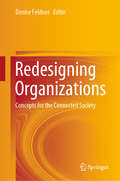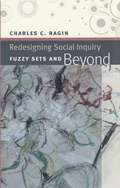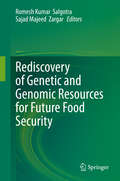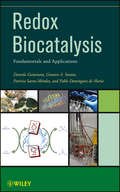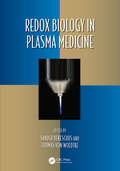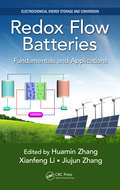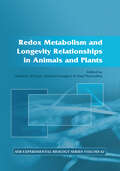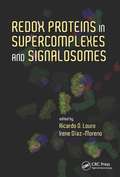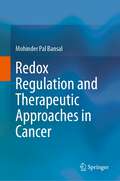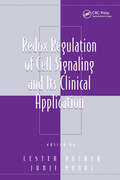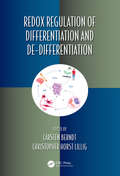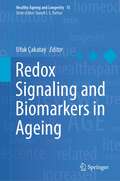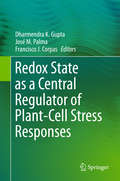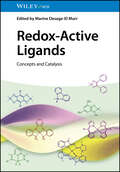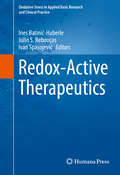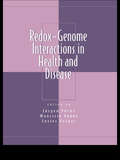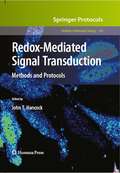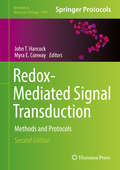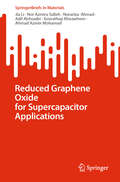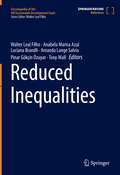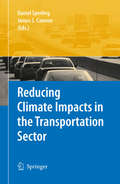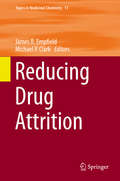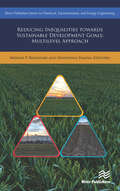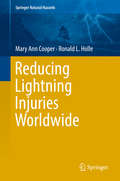- Table View
- List View
Redesigning Organizations: Concepts for the Connected Society
by Denise FeldnerThis book offers readers a deeper understanding of the Cyberspace, of how institutions and industries are reinventing themselves, helping them excel in the transition to a fully digitally connected global economy. Though technology plays a key part in this regard, societal acceptance is the most important underlying condition, as it poses pressing challenges that cut across companies, developers, governments and workers. The book explores the challenges and opportunities involved, current and potential future concepts, critical reflections and best practices. It addresses connected societies, new opportunities for governments, the role of trust in digital networks, and future education networks. In turn, a number of representative case studies demonstrate the current state of development in practice.
Redesigning Social Inquiry: Fuzzy Sets and Beyond
by Charles C. RaginFor over twenty years Charles C. Ragin has been at the forefront of the development of innovative methods for social scientists. In Redesigning Social Inquiry, he continues his campaign to revitalize the field, challenging major aspects of the conventional template for social science research while offering a clear alternative. Redesigning Social Inquiry provides a substantive critique of the standard approach to social research- namely, assessing the relative importance of causal variables drawn from competing theories. Instead, Ragin proposes the use of set-theoretic methods to find a middle path between quantitative and qualitative research. Through a series of contrasts between fuzzy-set analysis and conventional quantitative research, Ragin demonstrates the capacity for set-theoretic methods to strengthen connections between qualitative researchers' deep knowledge of their cases and quantitative researchers' elaboration of cross-case patterns. Packed with useful examples,Redesigning Social Inquiry will be indispensable to experienced professionals and to budding scholars about to embark on their first project.
Redesigning the Clinical Effectiveness Research Paradigm: Innovation and Practice-Based Approaches - Workshop Summary
by Institute of Medicine J. Michael Mcginnis Leighanne Olsen Roundtable On Value Science-Driven Health CareRecent scientific and technological advances have accelerated our understanding of the causes of disease development and progression,and resulted in innovative treatments and therapies. Ongoing work to elucidate the effects of individual genetic variation on patient outcomes suggests the rapid pace of discovery in the biomedical sciences will only accelerate. However,these advances belie an important and increasing shortfall between the expansion in therapy and treatment options and knowledge about how these interventions might be applied appropriately to individual patients. The impressive gains made in Americans' health over the past decades provide only a preview of what might be possible when data on treatment effects and patient outcomes are systematically captured and used to evaluate their effectiveness. Needed for progress are advances as dramatic as those experienced in biomedicine in our approach to assessing clinical effectiveness. In the emerging era of tailored treatments and rapidly evolving practice,ensuring the translation of scientific discovery into improved health outcomes requires a new approach to clinical evaluation. A paradigm that supports a continual learning process about what works best for individual patients will not only take advantage of the rigor of trials,but also incorporate other methods that might bring insights relevant to clinical care and endeavor to match the right method to the question at hand. The Institute of Medicine Roundtable on Value & Science-Driven Health Care's vision for a learning healthcare system,in which evidence is applied and generated as a natural course of care,is premised on the development of a research capacity that is structured to provide timely and accurate evidence relevant to the clinical decisions faced by patients and providers. As part of the Roundtable's Learning Healthcare System series of workshops,clinical researchers,academics,and policy makers gathered for the workshop Redesigning the Clinical Effectiveness Research Paradigm: Innovation and Practice-Based Approaches. Participants explored cutting-edge research designs and methods and discussed strategies for development of a research paradigm to better accommodate the diverse array of emerging data resources,study designs,tools,and techniques. Presentations and discussions are summarized in this volume.
Rediscovery of Genetic and Genomic Resources for Future Food Security
by Romesh Kumar Salgotra Sajad Majeed ZargarThis book describes how the latest genomic resources techniques can be efficiently used in plant breeding programmes to achieve food security in the future. It also shares insights on how to utilize the untapped and unexplored genetic diversity of wild species, wild relatives and landraces for crop improvement.Moreover, the book offers an impressive array of balanced analyses, fresh ideas and perspectives, and thoughtful and realistic proposals regarding the sustainable utilization of plant genetic resources with modern biotechnological techniques. The first book to address the importance of plant genetics and genomic resources for food security, it brings together a group of plant breeders and biotechnologists to investigate the use of genomic resources techniques in plant breeding programmes. Providing essential information on the efficient utilization of genomic resources in precision breeding, it offers a valuable asset for undergraduate and graduate students, teachers and professionals engaged in related fields.
Redox Biocatalysis
by Pablo Domínguez de María Patricia Saenz Méndez Gustavo Seoane Daniela GamenaraPaves the way for new industrial applications using redox biocatalysisIncreasingly, researchers rely on the use of enzymes to perform redox processes as they search for novel industrial synthetic routes. In order to support and advance their investigations, this book provides a comprehensive and current overview of the use of redox enzymes and enzyme-mediated oxidative processes, with an emphasis on the role of redox enzymes in chemical transformations. The authors examine the full range of topics in the field, from basic principles to new and emerging research and applications. Moreover, they explore everything from laboratory-scale procedures to industrial manufacturing.Redox Biocatalysis begins with a discussion of the biochemical features of redox enzymes as well as cofactors and cofactor regeneration methods. Next, the authors present a variety of topics and materials to the research and development of full-scale industrial applications, including:Biocatalytic applications of redox enzymes such as dehydrogenases, oxygenases, oxidases, and peroxidasesEnzyme-mediated oxidative processes based on biocatalytic promiscuityAll the steps from enzyme discovery to robust industrial processes, including directed evolution, high-throughput screening, and medium engineeringCase studies tracing the development of industrial applications using biocatalytic redox reactionsEach chapter ends with concluding remarks, underscoring the key scientific principles and processes. Extensive references serve as a gateway to the growing body of research in the field.Researchers in both academia and industry will find this book an indispensable reference for redox biotransformations, guiding them from underlying core principles to new discoveries and emerging industrial applications.
Redox Biology in Plasma Medicine (Oxidative Stress and Disease)
by Thomas Von Woedtke Sander BekeschusPlasma medicine uses non-equilibrium plasmas generated under atmospheric-pressure conditions. Therapeutical plasmas can stimulate tissue regeneration or inactivate cancer cells. This book reviews the interrelation between plasma chemistry and biochemistry complemented by discussion of the ways plasmas inactivate various pathogens. Focus is on the plasma effects on mammalian cells, subsequent consequences for cell-biological processes, and plasma applicability specific medical therapies. Contributions illustrate the ways cold atmospheric-pressure plasma can be used as a controllable source of redox-active species and as a useful tool for research in redox biology.Key Features Summarizes plasma chemistry, biochemistry, and microbiology Documents the ways plasmas interact with lipids, membranes, and cells Reviews therapeutic uses of plasmas in medicine Focuses on uses of plasmas as cancer treatment
Redox Flow Batteries: Fundamentals and Applications (Electrochemical Energy Storage and Conversion)
by Jiujun Zhang Huamin Zhang Xianfeng LiFlow batteries have received attention in large-scale energy storage due to their flexible design, high safety, high energy efficiency, and environmental friendliness. In recent years, they have been rapidly developed and tested in a variety of scales that prove their feasibility and advantages of use. As energy becomes a global focus, it is important to consider flow battery systems. This book offers a detailed introduction to the function of different kinds of redox flow batteries, including vanadium flow batteries, as well as the electrochemical processes for their development, materials and components, applications, and near future prospects. Redox Flow Batteries: Fundamentals and Applications will give readers a full understanding of flow batteries from fundamentals to commercial applications.
Redox Metabolism and Longevity Relationships in Animals and Plants: Vol 62 (Society for Experimental Biology)
by Christine Foyer Richard Faragher Paul ThornalleyRedox Metabolism and Longevity Relationships in Animals and Plants focuses on the recent issues that have emerged in ageing research in both the animal and plant kingdoms. This volume reviews current concepts concerning cellular redox homeostatis and ageing in animals and plants, relationships to programmed cell death, the production of oxidants and dicarbonyls, the ways that different organisms perceive and respond to oxidative, nitration and glycation challenges, and how this might be intricately connected to ageing and lifespan.
Redox Proteins in Supercomplexes and Signalosomes
by Ricardo O. Louro Irene Díaz-MorenoGet Insight on the Function of Supercomplexes in Biological SystemsRedox Proteins in Supercomplexes and Signalosomes is one of the first books to explore the key role played by redox proteins and their interaction network in a wide range of essential cellular processes in all domains of life. The book explains how the mitochondrial respiratory chai
Redox Regulation and Therapeutic Approaches in Cancer
by Mohinder Pal BansalThis book aims to provide an association of the major redox-sensitive pathways and networks involved in cancer. The initial chapter of the book discusses basic information about oxidative stress, its generation, and regulation (redox regulation or redox homeostasis) via cell signaling in normal and cancer cells. The book also explores antioxidants and metabolic events in cancer cells compared to normal cells. It further covers the application of nanoparticles in redox regulation in cancer cells. The role of redox regulation in cancer therapy, its influence, and its involvement in programmed cell death (PCD), metastasis, immune system, p53, and cell cycle/DNA damage repair pathways have been discussed in separate chapters. It further reviews the importance of dietary phytochemicals in redox regulation in normal and cancer pathophysiology. Towards the end, the book focuses on the role of redox balance, especially in ROS-dependent cellular processes in cancer stem cells.
Redox Regulation of Cell Signaling and Its Clinical Application (Oxidative Stress and Disease)
by Lester Packer Junji YodoiPresents recent developments in the rapidly expanding field of redox regulation research. The book examines insights into intracellular communication and new techniques for diagnosing and treating diseases associated with oxidation and reduction. It focuses on important cellular mechanisms, such as redox reactions related to thioredoxin (TRX)/adult
Redox Regulation of Differentiation and De-differentiation (Oxidative Stress and Disease #48)
by Carsten Berndt Christopher Horst LilligCell differentiation and the development of multicellular organisms are processes of self-assembly, controlled and driven by signaling molecules and cascades including redox regulation. These reactions may have provided the energy for the first metabolic steps in the evolution of life. Today, redox modifications are established as important regulatory events in cellular functions including differentiation and development. Redox modifications of single cysteines regulate differentiation of stem cells, formation of functioning organs, and de-differentiation such as formation of cancer cells. Current cancer therapy is based on redox events as well and regeneration often reactivates developmental pathways. Understanding differentiation and de-differentiation on a molecular level is therefore a prerequisite for the continuing development of new medical therapies. This book summarizes the roles of redox regulation in development by bringing together different concepts and comparing similarities and differences between various cell types and species. An international team of contributors presents several new aspects of redox-regulated differentiation and de-differentiation, including aspects of redox medicine. Key Features Provides the first summary on this important topic Reviews redox-dependent development of model organisms and single organs Highlights the redox-regulated pathways important for differentiation processes Illustrates the potential of redox medicine Combines state-of-the-art knowledge in differentiation/development, aging/longevity, and repair/regeneration Written by leading experts in the field Related Titles Ayyanathan, K., ed. Cancer Cell Signaling: Targeting Signaling Pathways Toward Therapeutic Approaches to Cancer (ISBN 978-1-77188-067-1) Clarke, M. & J. Frampton. Stem Cells: Biology and Application (ISBN 9780-8153-4511-4) Lim, W. & B. Mayer. Cell Signaling: Principles and Mechanisms (ISBN 978-0-8153-4244-1) Wong, E., ed. Autophagy and Signaling (ISBN 978-0-367-65772-7)
Redox Signaling and Biomarkers in Ageing (Healthy Ageing and Longevity #15)
by Ufuk ÇakatayThis book aims to present the age-related alterations in redox signaling networks and their diagnostic biomarkers in aging cells using multidisciplinary approach. Establishing sensitive and specific biomarkers of dynamic redox homeostasis is crucially important in the development of effective antiaging and senolytic interventions. Recent years have seen tremendous advances in the understanding of redox signaling events which highlight the process of aging and age-related pathologies. A major challenge in biological aging research is developing reliable biomarkers to determine the consequences of disrupted redox signaling networks long before the clinical diagnosis of age-related diseases is made. Therefore, we have chosen to concentrate on aging-induced aberrant redox signaling networks, their biomarkers, and pathological consequences in this book. Although oxidation is a natural metabolic process, the imbalance in the level of oxidants and antioxidants causes oxidative stress and eventually leads to inflammatory conditions, diabetes, neurodegenerative diseases, and cancer. Novel redox-sensitive biomarkers for the evaluation of aging-induced proteinopathies such as amyloid ß and tau proteins in Alzheimer's disease, α-synuclein in Parkinson's disease, and islet amyloid polypeptides in type 2 diabetes mellitus recently drew the attention of researchers. Inside this textbook, readers will find comprehensive perspectives on the association between redox homeostasis and the aging process both at the molecular and clinical levels. Due to the inherent relationship between impaired metabolic activities and oxidative stress, the temporal interaction between intermediary metabolism and disturbed redox status can lead to greater susceptibility to aging-induced diseases and disorders, such as cardiovascular diseases, hypertension, and diabetes. This knowledge could be a key to continued research toward improving medication regimens such as in cancer and cardiovascular therapies, and procedural outcomes for patients. This book brings together current research evidence and knowledge on redox signaling and biomarkers in aging in chapters written by leading global experts in this rapidly evolving field. We hope that this textbook is of interest to a wide group of researchers, advanced students, scientifically curious non-specialist readers and clinicians alike.
Redox State as a Central Regulator of Plant-Cell Stress Responses
by Francisco J. Corpas Dharmendra K. Gupta José M. PalmaThis book provides an up-to-date overview of redox signaling in plant cells and its key role in responses to different stresses. The chapters, which are original works or reviews, focus on redox signaling states; cellular tolerance under different biotic and abiotic stresses; cellular redox homeostasis as a central modulator; redox homeostasis and reactive oxygen species (ROS); redox balance in chloroplasts and mitochondria; oxidative stress and its role in peroxisome homeostasis; glutathione-related enzyme systems and metabolism under metal stress; and abiotic stress-induced redox changes and programmed cell death. The book is an invaluable source of information for plant scientists and students interested in redox state chemistry and cellular tolerance in plants.
Redox-Active Ligands: Concepts and Catalysis
by Marine Desage-El MurrRedox-Active Ligands Authoritative resource showcasing a new family of ligands that can lead to better catalysts and promising applications in organic synthesis Redox-Active Ligands gives a comprehensive overview of the unique features of redox-active ligands, describing their structure and synthesis, the characterization of their coordination complexes, and important applications in homogeneous catalysis. The work reflects the diversity of the subject by including ongoing research spanning coordination chemistry, organometallic chemistry, bioinspired catalysis, proton and electron transfer, and the ability of such ligands to interact with early and late transition metals, lanthanides, and actinides. The book is divided into three parts, devoted to introduction and concepts, applications, and case studies. After the introduction on key concepts related to the field, and the different types of ligands and complexes in which ligand-centered redox activity is commonly observed, mechanistic and computational studies are described. The second part focuses on catalytic applications of redox-active complexes, including examples from radical transformations, coordination chemistry and organic synthesis. Finally, case studies of redox-active guanidine ligands, and of lanthanides and actinides are presented. Other specific sample topics covered include: An overview of the electronic features of redox-active ligands, covering their historical perspective and biological backgroundThe versatility and mode of action of redox-active ligands, which sets them apart from more classic and tunable ligands such as phosphines or N-heterocyclic carbenesPreparation and catalytic applications of complexes of stable N-aryl radicals Metal complexes with redox-active ligands in H+/e- transfer transformations By providing up-to-date information on important concepts and applications, Redox-Active Ligands is an essential reading for researchers working in organometallic and coordination chemistry, catalysis, organic synthesis, and (bio)inorganic chemistry, as well as newcomers to the field.
Redox-Active Therapeutics
by Ines Batinić-Haberle Júlio S. Reboucas Ivan SpasojevićThis essentialvolume comprehensively discusses redox-active therapeutics, focusingparticularly on their molecular design, mechanistic, pharmacological andmedicinal aspects. The first section of the book describes the basicaspects of the chemistry and biology of redox-active drugs and includes a briefoverview of the redox-based pathways involved in cancer and the medical aspectsof redox-active drugs, assuming little in the way of prior knowledge. Subsequent sections and chapters describe more specialized aspects of central nervous system injuries, neurodegenerativediseases, pain, radiation injury and radioprotection (such as of brain, lungs, headand neck and erectile function) and neglected diseases (e. g. , leishmaniasis). It encompasses several major classes of redox-active experimental therapeutics, whichinclude porphyrins, salens, nitrones, and most notably metal-containing (e. g. ,Mn, Fe, Cu, Zn, Sb) drugs as either single compounds or formulations withnanomaterials and quantum dots. Numerous illustrations, tablesand figures enhance and complement the text; extensive references to relevantliterature are also included. Redox-Active Therapeutics is an invaluable addition to Springer's OxidativeStress in Applied Basic Research and Clinical Practice series. It is essential reading for researchers, clinicians and graduate studentsinterested in understanding and exploring the Redoxome--the organism redoxnetwork--as an emerging frontier in drug design, redox biology and medicine.
Redox-Genome Interactions in Health and Disease (Oxidative Stress and Disease #Vol. 10)
by Jürgen Fuchs Maurizio PoddaAt the nexus of advances in molecular genetics and findings in redox biology, this volume elaborates on the dynamics governing cellular redox states and aggregates the body of evidence linking oxidative stress and redox modulation with a host of monogenetic and polygenetic diseases.
Redox-Mediated Signal Transduction
by John T. HancockOnce believed to be involved mainly with energetics, including the production of ATP, knowledge of the role of redox in the control of cellular activity has been expanded over recent years. In Redox-Mediated Signal Transduction: Methods and Protocols, experienced researchers with backgrounds in both the plant and animal sciences contribute timely methods and techniques that can be used to study this important aspect of biology. Beginning with an overview and methods for measuring compounds that affect redox and the redox state of cells, the book continues with reviews of the use of GFP and its derivatives, methods to study the impact of changing redox on proteins, and methods to study the exact molecular changes that may underlie the mechanisms of action of altering redox, among other subjects. As a volume in the highly successful Methods in Molecular BiologyTM series, chapters include step-by-step, readily reproducible protocols, lists of the necessary materials and reagents, and tips on troubleshooting and avoiding known pitfalls. Cutting-edge and easy to use, Redox-Mediated Signal Transduction: Methods and Protocols is an ideal reference for those who wish to enter this exciting area of research as well as for those who simply wish for a more thorough understanding of the dramatic impact of redox in the control of cellular function.
Redox-Mediated Signal Transduction: Methods and Protocols (Methods in Molecular Biology #1990)
by John T. Hancock Myra E. ConwayThis volume explores the scope of the cellular redox analysis and the importance of not being limited by frequently changing and evolving technology. The chapters in this book cover a wide range of topics such as redox components in animal and plant cells and the role of reactive oxygen species, reactive nitrogen species, and hydrogen sulphide in cell signaling; measuring modifications using Flow Cytometry, ELISA assays, and Western blot analysis; measurement of oxidative stress in mitochondira and biological systems; and the use of the genetically encoded fluorescent probe HyPer. Written in the highly successful Methods in Molecular Biology series format, chapters include introductions to their respective topics, lists of the necessary materials and reagents, step-by-step, readily reproducible laboratory protocols, and tips on troubleshooting and avoiding known pitfalls. Cutting-edge and informative, Redox-Mediated Signal Transduction: Methods and Protocols, Second Edition is a valuable resource for both novice and expert researchers who want to expand their studies into new areas and new systems in the evolving redox field.
Reduced Graphene Oxide for Supercapacitor Applications (SpringerBriefs in Materials)
by Jia Li Ahmad Azmin Mohamad Nor Azmira Salleh Norariza Ahmad Adil Alshoaibi Soorathep KheawhomThis book offers a comprehensive exploration of reduced graphene oxide (rGO), a material at the forefront of energy storage technology, particularly in supercapacitors. Focused on researchers, engineers, and students in materials science and energy storage fields, this book systematically covers the synthesis, properties, and applications of rGO, emphasizing its potential to revolutionize supercapacitor performance through enhanced energy density, capacitance, and stability. This book is crucial for those involved in energy storage research and development because it addresses the growing need for materials that can offer higher energy density and better cycle life in supercapacitors. By focusing on rGO, a material that combines the best properties of graphene and graphene oxide, the book provides a pathway to overcoming the limitations of current energy storage systems. This book is designed for researchers, engineers, students, and professionals in the fields of materials science, nanotechnology, and energy storage, particularly those focused on the development of next-generation supercapacitors and related technologies.
Reduced Inequalities (Encyclopedia of the UN Sustainable Development Goals)
by Walter Leal Filho Tony Wall Luciana Brandli Anabela Marisa Azul Amanda Lange Salvia Pinar Gökçin ÖzuyarThe problems related to the process of industrialisation such as biodiversity depletion, climate change and a worsening of health and living conditions, especially but not only in developing countries, intensify. Therefore, there is an increasing need to search for integrated solutions to make development more sustainable. The United Nations has acknowledged the problem and approved the “2030 Agenda for Sustainable Development”. On 1st January 2016, the 17 Sustainable Development Goals (SDGs) of the Agenda officially came into force. These goals cover the three dimensions of sustainable development: economic growth, social inclusion and environmental protection. The Encyclopedia of the UN Sustainable Development Goals comprehensively addresses the SDGs in an integrated way. The Encyclopedia encompasses 17 volumes, each one devoted to one of the 17 SDGs. This volume addresses SDG 10, namely "Reduce inequality within and among countries", but also includes inequalities in income as well as those based on age, sex, disability, race, ethnicity, origin, religion or economic or other status within a country. The Goal also addresses inequalities among countries, including those related to representation, migration and development assistance. This volume contains the description of a range of terms, to allow a better understanding and foster knowledge about it.Concretely, the identified targets are:Progressively achieve and sustain income growth of the bottom 40 per cent of the population at a rate higher than the national averageEmpower and promote the social, economic and political inclusion of all, irrespective of age, sex, disability, race, ethnicity, origin, religion or economic or other statusEnsure equal opportunity and reduce inequalities of outcome, including by eliminating discriminatory laws, policies and practices and promoting appropriate legislation, policies and action in this regardAdopt policies, especially fiscal, wage and social protection policies, and progressively achieve greater equalityImprove the regulation and monitoring of global financial markets and institutions and strengthen the implementation of such regulationsEnsure enhanced representation and voice for developing countries in decision-making in global international economic and financial institutions in order to deliver more effective, credible, accountable and legitimate institutionsFacilitate orderly, safe, regular and responsible migration and mobility of people, including through the implementation of planned and well-managed migration policiesImplement the principle of special and differential treatment for developing countries, in particular least developed countries, in accordance with World Trade Organization agreementsEncourage official development assistance and financial flows, including foreign direct investment, to states where the need is greatest, in particular least developed countries, African countries, small island developing states and landlocked developing countries, in accordance with their national plans and programmesReduce to less than 3 per cent the transaction costs of migrant remittances and eliminate remittance corridors with costs higher than 5 per centEditorial BoardMd. Mahmudul Alam, Olga Bialostocka, José Baltazar Salgueirinho Osório de Andrade Guerra, Narasimha Reddy Donthi, Ulla A. Saari, Daniele Vieira, Amanda Lange Salvia
Reducing Climate Impacts in the Transportation Sector
by James S. Cannon Daniel SperlingMore than 250 experts from around the world gathered at the Asilomar Transportation and Energy Conference in August 2007 to tackle what many agree is the greatest environmental challenge the world faces: climate change. This 11th Biennial Conference, organized under the auspices of the Energy and Alternative Fuels Committees of the U.S. Transportation Research Board, examined key climate change policy issues and strategies to combat climate impacts from the transportation sector, a leading source of greenhouse gas emissions. This book includes chapters by leading presenters at the Asilomar Conference that reflect the most current views of the world's experts about a critical and rapidly evolving energy and environmental problem. The chapters in this book examine increasing worldwide emissions of greenhouse gases, uncertain oil supply, evolving climate change science, public attitudes toward climate change, and the implications for the U.S. of growth in China, India and elsewhere. They propose methods to reduce growth in vehicle travel through alternative fuel, new technologies, and land use planning. They examine the costs and the potential for greenhouse gas reduction through deployment of advanced technology and alternative fuels and propose strategies to motivate consumers to buy fuel efficient and alternative fuel vehicles, including heavy duty trucks.
Reducing Drug Attrition
by James R. Empfield Michael P ClarkMedicinal chemistry is both science and art. The science of medicinal chemistry offers mankind one of its best hopes for improving the quality of life. The art of medicinal chemistry continues to challenge its practitioners with the need for both intuition and experience to discover new drugs. Hence sharing the experience of drug research is uniquely beneficial to the field of medicinal chemistry. Drug research requires interdisciplinary team-work at the interface between chemistry, biology and medicine. Therefore, the topic-related series Topics in Medicinal Chemistry covers all relevant aspects of drug research, e. g. pathobiochemistry of diseases, identification and validation of (emerging) drug targets, structural biology, drugability of targets, drug design approaches, chemogenomics, synthetic chemistry including combinatorial methods, bioorganic chemistry, natural compounds, high-throughput screening, pharmacological in vitro and in vivo investigations, drug-receptor interactions on the molecular level, structure-activity relationships, drug absorption, distribution, metabolism, elimination, toxicology and pharmacogenomics. In general, special volumes are edited by well known guest editors.
Reducing Inequalities Towards Sustainable Development Goals: Multilevel Approach
by Medani P. BhandariThe Sustainable Development Goals (SDGs) are a set of global goals that meet some of the most pressing challenges facing our world today. Goal 10 concerns reducing global inequalities. Inequality is currently seen in the social, political, and economic structures of communities at both the national and international level. The United Nation’s approach to sustainable development is to create a set of goals and targets try to minimize the accelerating gaps of inequality. The book presents new insights for evaluating the progress on SDGs (especially goal 10), it also boldly sets new economic, social and environmental targets for reducing inequality. Using case studies, this book encourages readers to view economic development through the lens of growing inequalities and disparities. Such inequalities are clearly becoming more obvious as the world is better connected, and information is quickly shared. The books main aim is therefore to direct the efforts of scholars, practitioners and policymakers to swiftly find the balance between the three pillars of sustainable development. The main challenges and focus of each chapter are different and collectively they give an integrated understanding of the phenomenon of sustainable development and its diverse aspects. This book will be useful for policymakers, social and environmental activists, agencies, educators and practitioners in the sphere of social or environmental economics. The methodology of the research can be replicated and taken forward by future researchers in the field.
Reducing Lightning Injuries Worldwide (Springer Natural Hazards)
by Mary Ann Cooper Ronald L. HolleThis book is a resource for understanding why Lightning continues to be a major health hazard, especially in the developing world, and equips researchers, governments, and public health advocates with the knowledge and techniques needed to reduce lightning casualties worldwide.
